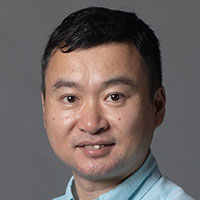
November 18, 8:00am - 8:45am
Hanqing Jiang
Westlake University
Presenting in Track 8: Dynamics, Vibration & Control
Presentation Title: Mechanics and Devices for Mechanical Haptics
Abstract: Unlike visual or auditory stimuli, touch commands immediate attention and elicits instinctive reactions, making it essential for environmental interactions, personal safety, and emotional connections. The sense of touch is fundamental to our perception of the world, providing critical sensory feedback that enhances dexterity, proprioception, and social communication. Recent advancements in bioelectronics have transformed traditional haptic devices into wearable and adaptable systems, unlocking new possibilities for tactile interactions in virtual and physical environments. However, existing wearable haptic interfaces are often constrained by unimodal feedback, continuous energy demands, limited spatial resolution, and challenges in seamless attachment to the body, restricting their potential for real-world applications.
This talk will cover recent progress in mechanical haptics developed in my group, focusing on both wearable and structured approaches to enhancing tactile interactions. We will introduce curved origami-based stiffness manipulation, enabling in situ stiffness switching across positive, zero, and negative ranges. This approach provides unprecedented control over mechanical compliance, with applications in robotics, prosthetics, and a novel first-person haptic device that synchronizes with virtual environments to replicate realistic material perception. By leveraging the geometric reconfigurability of origami structures, we demonstrate how programmable stiffness can enhance tactile realism and user experience in interactive systems.
Additionally, we will present a wireless, real-time haptic interface that leverages a mechanically bistable mechanism inspired by the Kresling origami pattern. This innovative design enables diverse tactile sensations—including normal pressure, shear force, and vibrations—by storing and releasing mechanical energy through the skin. Unlike conventional actuators that require continuous power input, this bistable mechanism capitalizes on mechanical energy retention to provide energy-efficient and programmable haptic feedback, making it particularly suitable for long-duration wearable applications.
Furthermore, we will discuss a bistable soft-pneumatic textile interface designed for full-body haptics, offering multimodal touch feedback for immersive and assistive applications. By integrating flexible, soft actuators with programmable bistability, this interface achieves spatially distributed and temporally controlled haptic feedback across large surface areas, enabling applications in virtual reality, rehabilitation, and remote communication. Its energy-efficient operation and adaptability to various body regions present a transformative step in wearable haptic technology.
These advancements represent a paradigm shift in haptic technology, broadening its applications in human-machine interactions, medical rehabilitation, gaming, and immersive digital experiences. By addressing the limitations of current haptic systems and leveraging interdisciplinary innovations in mechanics, materials, and bioelectronics, our research paves the way for next-generation haptic interfaces that are more versatile, efficient, and seamlessly integrated into everyday life.
Biography: Hanqing Jiang is a Chair Professor of Mechanical Engineering at Westlake University, China. Before joining Westlake in June 2021, he was a faculty member in Mechanical Engineering at Arizona State University from 2006 to 2021. He earned his Ph.D. in Solid Mechanics from Tsinghua University in 2001. His research focuses on origami- and kirigami-based mechanical metamaterials for robotics and human-machine interactions, lithium-metal batteries, and unconventional electronics. He has authored five book chapters and over 150 peer-reviewed journal papers. He was elected an ASME Fellow in 2016, a member of the European Academy of Sciences and Arts in 2024, and a member of the European Academy of Sciences in 2024. He currently serves as Chair of the Executive Committee of the ASME Materials Division and was President of the Society of Engineering Science in 2022. His selected honors include an NSF CAREER Award (2009), the ASME Worcester Reed Warner Medal (2021), and the Yonggang Huang Engineering Science Medal (2025).